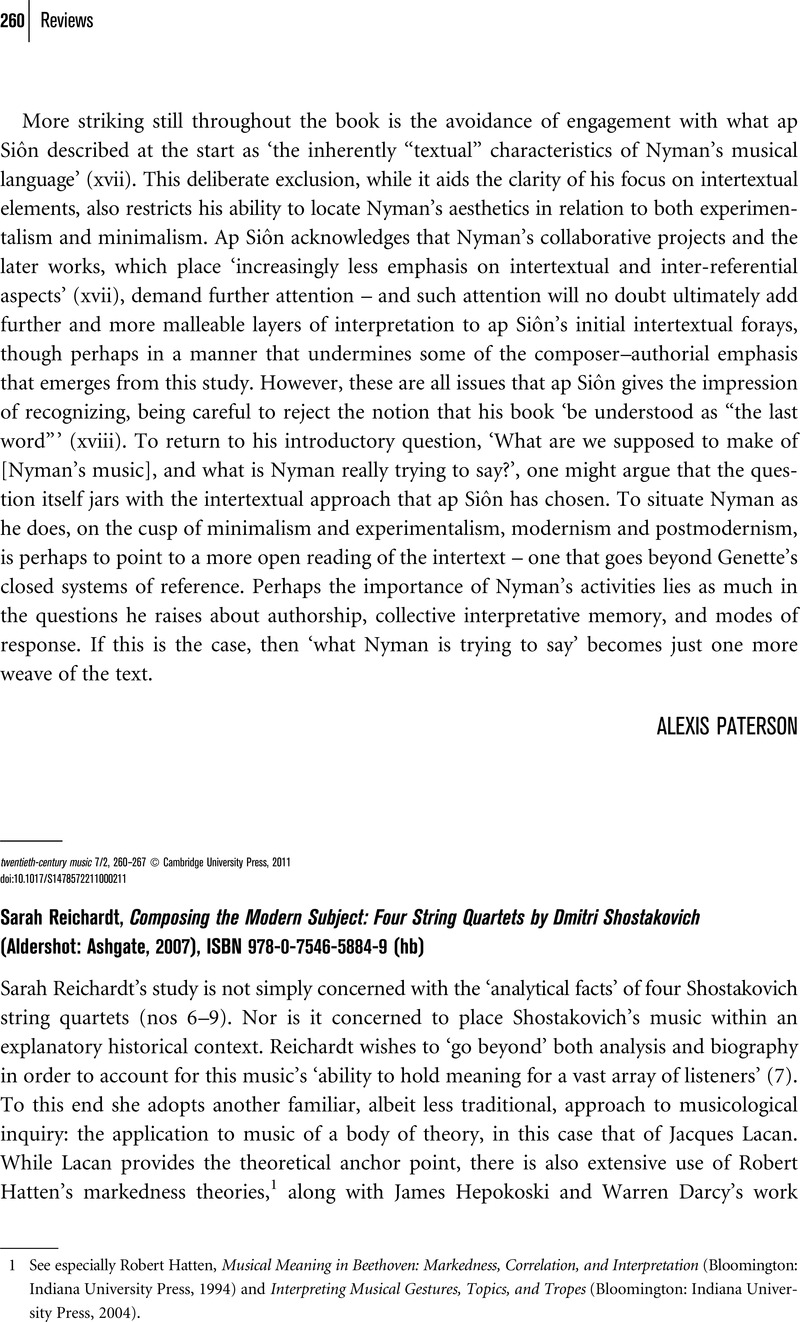No CrossRef data available.
Published online by Cambridge University Press: 29 November 2011

1 See especially Hatten, Robert, Musical Meaning in Beethoven: Markedness, Correlation, and Interpretation (Bloomington: Indiana University Press, 1994)Google Scholar and Interpreting Musical Gestures, Topics, and Tropes (Bloomington: Indiana University Press, 2004)Google Scholar.
2 Hepokoski, James and Darcy, Warren, Elements of Sonata Theory: Norms, Types, and Deformations in the Late-Eighteenth-Century Sonata (New York: Oxford University Press, 2006)CrossRefGoogle Scholar.
3 Homer, Sean, Jacques Lacan (London: Routledge, 2005), 45CrossRefGoogle Scholar.
4 The quotations are from Kramer, Lawrence, Musical Meaning: a Critical History (Berkeley: University of California Press, 2001), 7CrossRefGoogle Scholar.
5 Žižek, Slavoj, Looking Awry: an Introduction to Jacques Lacan through Popular Culture (Cambridge, MA: MIT Press: 1992)Google Scholar.
6 Hooper, Giles, The Discourse of Musicology (Aldershot: Ashgate, 2006), 125Google Scholar.
7 Cook, Nicholas and Dibben, Nicola, ‘Musicological Approaches to Emotion’, in Music and Emotion: Theory and Research, ed. Juslin, Patrick N. and Sloboda, John A. (Oxford: Oxford University Press, 2001), 62Google Scholar.
8 This point is discussed at some length by Klein, Michael in ‘Chopin's Fourth Ballade as Musical Narrative’, Music Theory Spectrum 26/1 (2004), 23–55CrossRefGoogle Scholar. See also page 2 of the book under review.
9 Bruce Fink gives a standard definition of S(![]() ) as the ‘[s]ignifier of the lack in the other’, but its relationship to the real is made more overt by Žižek's explanation of it as ‘the mark of the fact that “the Other (as a closed, consistent totality) doesn't exist”’ and as ‘the little bit of the real functioning as a signifier of the ultimate senselessness of the (symbolic) universe’; see Fink, , The Lacanian Subject: between Language and Jouissance (Princeton: Princeton University Press, 1995), 173 and 135Google Scholar, and Žižek, Looking Awry, 135.
) as the ‘[s]ignifier of the lack in the other’, but its relationship to the real is made more overt by Žižek's explanation of it as ‘the mark of the fact that “the Other (as a closed, consistent totality) doesn't exist”’ and as ‘the little bit of the real functioning as a signifier of the ultimate senselessness of the (symbolic) universe’; see Fink, , The Lacanian Subject: between Language and Jouissance (Princeton: Princeton University Press, 1995), 173 and 135Google Scholar, and Žižek, Looking Awry, 135.
10 Foucault, Michel, The Order of Things: an Archaeology of the Human Sciences (London: Tavistock, 1970)Google Scholar.
11 See Attali, Jacques, Noise: the Political Economy of Music, trans. Massumi, Brian (Manchester: Manchester University Press, 1985)Google Scholar.
12 Fink notes that objet petit a has a number of faces in Lacan's thought, but it seems to be most commonly encountered as ‘the Other's desire which serves as the subject's cause of desire’ or simply as ‘the object cause of desire’ (Fink, The Lacanian Subject, 173). See also Homer, Jacques Lacan, 153.
13 Žižek, Looking Awry, 133–4.
14 Hepokoski and Darcy, Elements of Sonata Theory; Ivashkin, Alexander, ‘Shostakovich and Schnittke: the Erosion of Symphonic Syntax’, in Shostakovich Studies, ed. Fanning, David (Cambridge: Cambridge University Press, 1995), 254–70CrossRefGoogle Scholar; Cumming, Naomi, ‘The Horrors of Identification: Reich's Different Trains’, Perspectives of New Music 35/1 (1997), 129–52CrossRefGoogle Scholar.
15 Rival, Robert, ‘The Comfort of Denial: Metre, Cyclic Form, and Narrative in Shostakovich's Seventh Quartet’, twentieth-century music 6/2 (2009), 209–35CrossRefGoogle Scholar.
16 Fanning, David, Shostakovich: String Quartet no. 8 (Aldershot: Ashgate, 2004)Google Scholar.
17 Fink, The Lacanian Subject, 173.
18 Žižek, Looking Awry, 133.
19 See Kramer, Musical Meaning, 236. Kramer's discussion of the Eighth Quartet (232–41) forms part of the chapter entitled ‘Long Ride in a Slow Machine: the Alienation Effect from Weill to Shostakovich’.
20 Horowitz, Gregg, ‘Art History and Autonomy’, in The Semblance of Subjectivity: Essays in Adorno's Aesthetic Theory, ed. Huhn, Tom and Zuidervaart, Lambert (Cambridge, MA: MIT Press, 1997), 259–86Google Scholar.
21 This mapping is not helped by the mislabelling of Attali's second network as ‘ritual’ rather than ‘representation’. Moreover, the awkwardness of the mapping is highlighted by the author's own admission that the term ‘the real’ is used only once in Attali's seminal work Noise, and with no indication that it is intended in the Lacanian sense.
22 Bakhtin, Mikhail, ‘Epic and Novel’, in The Dialogic Imagination, ed. Holquist, Michael and trans. Emerson, Caryl and Holquist, Michael (Austin: University of Texas Press, 1981), 3–40Google Scholar.
23 E♭ minor, along with A♭, comes to extend the tonal scheme so that it comprises the tonal centres G, D, A♭, and E♭. These pitches, it is argued, ‘infect, as it were, the large-scale harmonic structure of the movement’ (30).
24 See Caplin, William E., Classical Form: a Theory of Formal Functions for the Instrumental Music of Haydn, Mozart, and Beethoven (New York: Oxford University Press, 1998), 16Google Scholar.